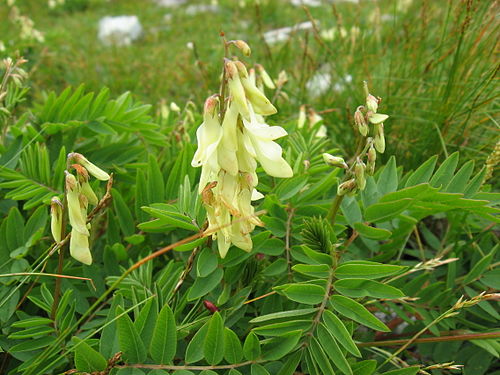Hedysarum micropterum: Red Data Book of Armenia

VU* B 1 ab(i, ii, iii) + 2ab (i,ii,iii)
Category. Vulnerable species. Grows in the area of intensive land development. The extent of occurrence and the area of occupancy are less than 500 km2. Taking into consideration relatively wide range of general distribution of the species, the category of threat has been downgraded to VU. It was included in the first edition of the Red Data Book of Armenia under Category 2: Rare species. It is not included in the Annexes of CITES and that of the Bern Convention.
Description. Perennial, glaucous, adpressed pilose plants. Stems branched, 10–30 cm. Leaflets 4–9–paired, linear, on the upper side glabrous, on the lower side pubescent, 15–40 x 1,5–2 mm. Inflorescence few–flowered. Corolla pink, 10–11 mm long. Legumes 1–3–articulate; articules densely farinose–villose and setose–aciculeate.
Distribution. In Armenia it occurs in Yerevan (Urts mountain range, surroundings of Zovashen, Dvin, Yeranos, Vedi, Yeraskh, Urtsadzor villages) floristic region. EOO is 240 km2, AOO is 28 km2, the number of locations is 3. Besides Armenia the species grows in Nakhichevan, Central Transcaucasia, West Iran, North Turkmenia.
Ecological, biological and phytocoenological peculiarities. Grows in lower and middle mountain belts, at the altitudes of 700–1800 meters above sea level, on dry stony, clay and sandy soil. Flowering from May to June, fruiting from June to July.
Limiting factors. Restricted extent of occurrence and area of occupancy, small density of the population, loss/degradation of habitats caused by land development.
Conservation actions. No conservation actions. Necessary: establishment of new specially protected nature area on Yerakh mountain range, monitoring of the population state.
Suggestions
 The Ministry of Environment sent a letter international partners to draw their attention to the real danger of environmental disasters as a result of Azerbaijan's large-scale aggression towards the territory of Armenia
The Ministry of Environment sent a letter international partners to draw their attention to the real danger of environmental disasters as a result of Azerbaijan's large-scale aggression towards the territory of Armenia
 Vicia pisiformis: Red Data Book of Armenia
Vicia pisiformis: Red Data Book of Armenia
 Vavilovia formosa: Red Data Book of Armenia
Vavilovia formosa: Red Data Book of Armenia
 Trigonella capitata: Red Data Book of Armenia
Trigonella capitata: Red Data Book of Armenia
 Trigonella astroides: Red Data Book of Armenia
Trigonella astroides: Red Data Book of Armenia












